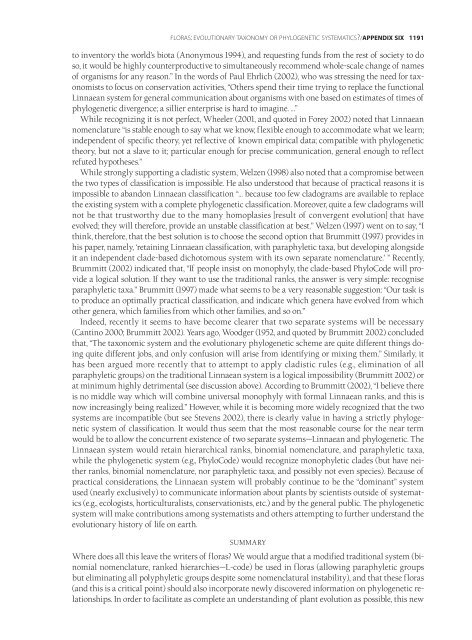Appendices & Glossary - Botanical Research Institute of Texas
Appendices & Glossary - Botanical Research Institute of Texas
Appendices & Glossary - Botanical Research Institute of Texas
You also want an ePaper? Increase the reach of your titles
YUMPU automatically turns print PDFs into web optimized ePapers that Google loves.
FLORAS: EVOLUTIONARY TAXONOMY OR PHYLOGENETIC SYSTEMATICS?/APPENDIX SIX<br />
1191<br />
to inventory the world’s biota (Anonymous 1994), and requesting funds from the rest <strong>of</strong> society to do<br />
so, it would be highly counterproductive to simultaneously recommend whole-scale change <strong>of</strong> names<br />
<strong>of</strong> organisms for any reason.” In the words <strong>of</strong> Paul Ehrlich (2002), who was stressing the need for taxonomists<br />
to focus on conservation activities, “Others spend their time trying to replace the functional<br />
Linnaean system for general communication about organisms with one based on estimates <strong>of</strong> times <strong>of</strong><br />
phylogenetic divergence; a sillier enterprise is hard to imagine. …”<br />
While recognizing it is not perfect, Wheeler (2001, and quoted in Forey 2002) noted that Linnaean<br />
nomenclature “is stable enough to say what we know, flexible enough to accommodate what we learn;<br />
independent <strong>of</strong> specific theory, yet reflective <strong>of</strong> known empirical data; compatible with phylogenetic<br />
theory, but not a slave to it; particular enough for precise communication, general enough to reflect<br />
refuted hypotheses.”<br />
While strongly supporting a cladistic system, Welzen (1998) also noted that a compromise between<br />
the two types <strong>of</strong> classification is impossible. He also understood that because <strong>of</strong> practical reasons it is<br />
impossible to abandon Linnaean classification “… because too few cladograms are available to replace<br />
the existing system with a complete phylogenetic classification. Moreover, quite a few cladograms will<br />
not be that trustworthy due to the many homoplasies [result <strong>of</strong> convergent evolution] that have<br />
evolved; they will therefore, provide an unstable classification at best.” Welzen (1997) went on to say, “I<br />
think, therefore, that the best solution is to choose the second option that Brummitt (1997) provides in<br />
his paper, namely, ‘retaining Linnaean classification, with paraphyletic taxa, but developing alongside<br />
it an independent clade-based dichotomous system with its own separate nomenclature.’ ” Recently,<br />
Brummitt (2002) indicated that, “If people insist on monophyly, the clade-based PhyloCode will provide<br />
a logical solution. If they want to use the traditional ranks, the answer is very simple: recognise<br />
paraphyletic taxa.” Brummitt (1997) made what seems to be a very reasonable suggestion: “Our task is<br />
to produce an optimally practical classification, and indicate which genera have evolved from which<br />
other genera, which families from which other families, and so on.”<br />
Indeed, recently it seems to have become clearer that two separate systems will be necessary<br />
(Cantino 2000; Brummitt 2002). Years ago, Woodger (1952, and quoted by Brummitt 2002) concluded<br />
that, “The taxonomic system and the evolutionary phylogenetic scheme are quite different things doing<br />
quite different jobs, and only confusion will arise from identifying or mixing them.” Similarly, it<br />
has been argued more recently that to attempt to apply cladistic rules (e.g., elimination <strong>of</strong> all<br />
paraphyletic groups) on the traditional Linnaean system is a logical impossibility (Brummitt 2002) or<br />
at minimum highly detrimental (see discussion above). According to Brummitt (2002), “I believe there<br />
is no middle way which will combine universal monophyly with formal Linnaean ranks, and this is<br />
now increasingly being realized.” However, while it is becoming more widely recognized that the two<br />
systems are incompatible (but see Stevens 2002), there is clearly value in having a strictly phylogenetic<br />
system <strong>of</strong> classification. It would thus seem that the most reasonable course for the near term<br />
would be to allow the concurrent existence <strong>of</strong> two separate systems—Linnaean and phylogenetic. The<br />
Linnaean system would retain hierarchical ranks, binomial nomenclature, and paraphyletic taxa,<br />
while the phylogenetic system (e.g., PhyloCode) would recognize monophyletic clades (but have neither<br />
ranks, binomial nomenclature, nor paraphyletic taxa, and possibly not even species). Because <strong>of</strong><br />
practical considerations, the Linnaean system will probably continue to be the “dominant” system<br />
used (nearly exclusively) to communicate information about plants by scientists outside <strong>of</strong> systematics<br />
(e.g., ecologists, horticulturalists, conservationists, etc.) and by the general public. The phylogenetic<br />
system will make contributions among systematists and others attempting to further understand the<br />
evolutionary history <strong>of</strong> life on earth.<br />
SUMMARY<br />
Where does all this leave the writers <strong>of</strong> floras? We would argue that a modified traditional system (binomial<br />
nomenclature, ranked hierarchies—L-code) be used in floras (allowing paraphyletic groups<br />
but eliminating all polyphyletic groups despite some nomenclatural instability), and that these floras<br />
(and this is a critical point) should also incorporate newly discovered information on phylogenetic relationships.<br />
In order to facilitate as complete an understanding <strong>of</strong> plant evolution as possible, this new
















